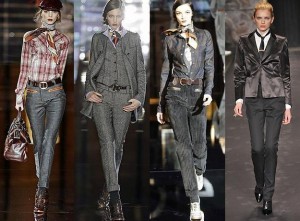 As Kurt from “Glee” once said, “Fashion knows no gender.” While this may be, men in skirts are jarring while women in suits are normal. Why is this? Sitting in the Periodical Room in Rush Rhees Library the other day, I watched as a stream of prospective female graduate students flocked into Messinger Study on what I assumed was a tour. Everyone dressed in a suit. I wanted to be struck by how well they “cleaned up,” but the whole crowd was really quite unexciting. A woman in a suit was once a statement, and it should still be a statement. How did that statement become lost to us? How will this new wave of androgyny in the fashion industry bring it back?
As Kurt from “Glee” once said, “Fashion knows no gender.” While this may be, men in skirts are jarring while women in suits are normal. Why is this? Sitting in the Periodical Room in Rush Rhees Library the other day, I watched as a stream of prospective female graduate students flocked into Messinger Study on what I assumed was a tour. Everyone dressed in a suit. I wanted to be struck by how well they “cleaned up,” but the whole crowd was really quite unexciting. A woman in a suit was once a statement, and it should still be a statement. How did that statement become lost to us? How will this new wave of androgyny in the fashion industry bring it back?
Historically, womens’ fashion has been more prone to borrowing from menswear than vice versa. What spurred this gender-blending, initially, was more than an aesthetic choice. It was a drive for women’s equality and suffrage in the ’20s. While the idea behind this was perhaps women’s desire to break free from sexual oppression, most designers of the time took it as an opportunity to explore the line that the industry drew between the two sexes. The signature chopped bob was one of the many correspondent looks. Corsets were discarded, drop-waist skirts were added to the flattened bosom effect, sportswear and loose-fitting daily wear became popular and acceptable and one Coco Chanel was bold enough to wear trousers. By the ’30s and ’40s, style icons such as Katharine Hepburn were sporting three-piece suits with ease and flair.
Skipping ahead just a wee bit, the ’80s saw another peak of androgyny with the publication of “The Woman’s Dress for Success Book” by John Molloy, which set into motion a trend of “corporate drag.” This decade of yuppies — and I use the term endearingly — also tapped into the concept of fashion androgyny.
This time it was not so much used as a weapon in favor of equality, but to promote equality in the workplace: a cutthroat display to say they mean business.
So now, in what may have been the briefest recap of androgyny’s role in fashion history ever penned, I bring us back to 2010. The androgyny rearing its head on recent runways has a creative license that previous waves of androgyny did not. Now that women have, arguably, attained rights as citizens and in the workplace, there is less of a social message pushing the surface look of a woman wearing a knock-out suit.
Elly Jackson of La Roux is one popular advocate of what I may refer to as the New Androgyny, with her uniform Viktor & Rolf-centric masculine attire and cropped ’do. Another is Janelle Monáe, who perhaps takes on a more Michael Jackson-inspired look of piecing suits with quirky feminine add-ons. Supermodel Agyness Deyn has long and famously paraded her scruffy pixie cut about the runway, but perhaps what shot her to stardom was her ability to pull off a flirty frock in addition to her go-to boyish look.
What these three fashionistas have in common (besides their short hair) is their exemplification of this New Androgyny: taking the borrowed principles of menswear and liberally adapting them to fit their own personal look. That is what I believe is important about this recent resurgence of androgyny in womenswear. At this point in history, androgyny is a purely stylistic choice, free of social or political attachments. It’s important to now think of androgyny as an aesthetic option that can be manipulated, transfigured and pulled apart by designers. This has already been happening in many houses (Dolce & Gabbana, Ralph Lauren, Bottega Veneta, Dries van Noten to name a few). In all honesty, you could look at any runway and see the effect that androgyny in fashion history has taken on the clothes available to us right now.
I’m not saying women should all wear suits just because we can. I’m saying that we should have the confidence to wear suits if we feel so inclined. I fear, especially in a college environment (where it seems important to make the opposite sex as aware as possible that we have curves and thighs), that we disregard boyish looks completely. This is a huge mistake. We have the opportunity to take these staples of menswear and incorporate them into our own feminine wardrobe for varied and unique looks. I think it’s time women in suits become jarring once more.

